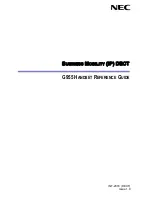
TD 92930EN
13 December 2013 /Ver B
Configuration Manual
WL3 and WL3 Plus WLAN Handset
46
6. Handset Configuration
1
In the applicable profile, select Presence and diversion.
2
Activate a diversion by selecting “On” in the applicable diversion drop-down lists.
The following diversions are possible:
•
Activate diversion for all calls
•
Activate diversion on user busy
•
Activate diversion on no answer
3
Enter the diversion number in the applicable diversion number text field.
6.7
Messaging and Alarm
The messaging and alarm functions are provided through the WSG and described in
the document Installation and Operation Manual, OpenStage Wireless Service
Gateway (WSG), TD 92442EN.
6.7.1
IP Address to the WSG
The WSG handles all communication between the WLAN and its built-in Centralized
Device Manager. It is possible to send messages from a web browser to a handset,
handle messages to groups, send simple messages from handset to handset (and to
groups), search for telephone numbers in a central database (on PC), have a central
telephone book on the WSG (not PC-based), and to provide absence handling in the
system.
1
Select Device > WSG.
2
In the IP address field, enter the IP address of the WSG. If empty, no messaging
or alarm function is available.
6.8
Messaging Settings
NOTE: Applicable to WL3 MessagingWL3 Plus only.
It is possible to configure how incoming messages are indicated and displayed in
handset.
Profiles > Normal, Profile 1- 4
•
Vibrator
Defines if the handset vibrates when receiving incoming calls and messages.
•
Message alert
Defines the message sound for incoming messages.
•
Message volume
Defines the message volume for incoming messages. By default, the message
volume follows the ringer volume, but a different message volume can be set with
this parameter.
Device > Messaging
•
Message list representation
Can be set to text or number.
•
Message text size
•
Time to read (TTR)
Defines if the user needs to close a message manually, or if the message
automatically closes when the TTR expires. Regardless of how a message is
closed, it is removed from the message queue and stored in the Messaging Inbox.















































